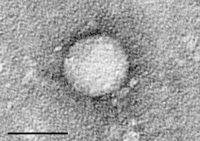
Photo from wikipedia
The vacuole is a unique plant organelle that plays an important role in maintaining cellular homeostasis under various environmental stress conditions. However, the effects of biotic stress on vacuole structure… Click to show full abstract
The vacuole is a unique plant organelle that plays an important role in maintaining cellular homeostasis under various environmental stress conditions. However, the effects of biotic stress on vacuole structure has not been examined using three-dimensional (3D) visualization. Here, we performed 3D electron tomography to compare the ultrastructural changes in the vacuole during infection with different viruses. The 3D models revealed that vacuoles are remodeled in cells infected with cucumber mosaic virus (CMV) or tobacco necrosis virus A Chinese isolate (TNV-AC ), resulting in the formation of spherules at the periphery of the vacuole. These spherules contain neck-like channels that connect their interior with the cytosol. Confocal microscopy of CMV replication proteins 1a and 2a and TNV-AC auxiliary replication protein p23 showed that all of these proteins localize to the tonoplast. Electron microscopy revealed that the expression of these replication proteins alone is sufficient to induce spherule formation on the tonoplast, suggesting that these proteins play prominent roles in inducing vacuolar membrane remodeling. This is the first report of the 3D structures of viral replication factories built on the tonoplasts. These findings contribute to our understanding of vacuole biogenesis under normal conditions and during assembly of plant (+) RNA virus replication complexes. This article is protected by copyright. All rights reserved.
Journal Title: Journal of integrative plant biology
Year Published: 2020
Link to full text (if available)
Share on Social Media: Sign Up to like & get
recommendations!